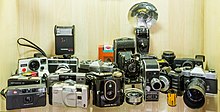User:Ftalebhaghighi
In archives, the term "audiovisual" is frequently used generically to denote materials other than written documents.[1] Films, videos, audio recordings, pictures, and other audio and visual media are collected in audiovisual archives.[2] A vast amount of knowledge is included in audiovisual records, which are considered cultural treasures and must be preserved for future use. Print materials would not have the same reach across various audiences as audiovisual resources.[3]

Audiovisual archiving—the collecting, preserving, management, and use of audiovisual heritage—has established its credentials as a distinct profession. The first audiovisual archives came into existence about a century ago, but sustained growth is basically a phenomenon of the second half of the 20th century.[2]
Since audiovisual records capture a wide range of information beyond that which may be found in written forms and act as effective, direct means of communication, they are included in official programs. Written words cannot match the distinct dimension that audio-visual content possesses. Combining sound and images, audio-visual information provides a level of communication that textual text cannot match. By utilizing the synergy of sight and sound, it enhances the overall comprehension and impact of the content by conveying emotions, context, and complicated concepts.[3]

The large number and variety of audiovisual materials have led to a major concern for many institutions: preservation. The goal of institutional preservation is to guarantee the materials' ongoing accessibility. The deterioration of audiovisual records is accelerated by improper handling and unsafe storage circumstances.[3]

The greatest barrier to the use of audiovisual materials stems from the fact that many of them are machine-dependent, which becomes a major barrier to their use in rural communities where the equipment and power supply might not be readily available.[3] A lot of archives are working hard to open up access to their holdings. They may work with educational institutions, sponsor exhibitions, and provide online venues for watching and listening to content.[4] The fragility of analog material, copyright constraints, and the quick development of digital forms provide obstacles for audiovisual archives.[5] Large-scale data management and preservation can be expensive and technically challenging. Digital technology advancements have boosted preservation techniques while also posing new difficulties.[6] To ensure the continuous usability of their collections, archives must stay abreast of changing standards and formats.[7] In particular, when working with sensitive or culturally relevant content, archives must straddle copyright and intellectual property rules as well as ethical considerations.[8] In order to ensure the continuous preservation of these priceless cultural materials, organizations and subject matter experts advocate for the benefits of audiovisual archiving and ask for funding and legislative support.[2]
Audio and visual assets with cultural, historical, and educational significance must be preserved and made available to the public through audiovisual archives. They are crucial for analysis, instruction, and the advancement of cultural heritage. They struggle to manage and preserve an ever-growing variety of analog and digital content, though.[2]
Principles
[edit]Like traditional archives but modified for visual and auditory media, audiovisual archives follow similar principles.[2] These principles include:
Provenance: Maintaining the original context and creator's intent for audiovisual materials. [9]
Original Order: Preserving the order and arrangement of audio and visual records as they were created or used. [9]
Access and Use: Balancing accessibility for research and education while respecting legal and ethical constraints like copyright and privacy. [9]
Preservation: Safeguarding audiovisual materials through digitization, proper storage, and restoration. [9]
Technology Integration: Staying up to date with evolving technologies to ensure the continued usability of digital formats and tools for managing and accessing audiovisual collections. These principles guide the organization, preservation, and accessibility of audiovisual materials. [10]
Standards
[edit]To ensure optimal management and preservation, audiovisual archives frequently follow several standards and models. The most well-liked ones consist of:
1. SMPTE The Society of Motion Picture and Television Engineers Timecode: A common standard for synchronizing audio and video in the broadcasting and film industries. [11]
2. MXF (Material Exchange Format): MXF is a standard file format for the interchange of audio and video material. It's common in professional video production and broadcast. [12]
3. PBCore: Developed by the Public Broadcasting Preservation Fellow project, PBCore is a metadata standard specifically designed for audiovisual materials in public broadcasting archives. [13]
4. FADGI (Federal Agencies Digitization Guidelines Initiative): FADGI provides guidelines and standards for digitization and preservation of audiovisual materials, especially for government agencies. [14]
5. PREMIS (Preservation Metadata: Implementation Strategies): PREMIS is a widely recognized metadata standard for digital preservation, including audiovisual content. [15]
6. OAIS (Open Archival Information System): The OAIS model is a reference model for digital preservation, helping organizations manage, preserve, and provide access to their audiovisual archives. [16]
7. METS (Metadata Encoding and Transmission Standard): METS is a standard for encoding descriptive, administrative, and structural metadata about objects within digital libraries, which can be applied to audiovisual materials. [17]
8. EAD (Encoded Archival Description): While primarily used for textual materials, EAD is often adapted for audiovisual collections, providing a standardized way to encode finding aids. [18]
9. Dublin Core: is a set of fifteen main metadata items for describing digital or physical resources.[19]
The management and sharing of audiovisual archives is made simpler for institutions because of these standards and models, which also guarantee their compatibility, accessibility, and long-term preservation. [20]
| This user is a student editor in University_of_Arizona/INFO_505_-_Foundations_of_Information_Science_(Fall). |
See also
[edit]- Archival informatics
- Archival research
- Archival science
- Archive file
- Archivist
- Archives management
- Audiovisual
- International Council on Archives
- Manuscript processing
- National Archives and Records Administration
- Preservation (library and archival science)
References
[edit]- ^ "SAA Dictionary: audiovisual". dictionary.archivists.org. Retrieved 2023-10-24.
- ^ a b c d e Edmondson, Ray (2016). "Audiovisual archiving: philosophy and principles". unesdoc.unesco.org. Retrieved 2023-10-19.
- ^ a b c d Lukileni-Iipinge, Hertha; Mnjama, Nathan (2017). "Preservation of Audio-Visual Records at the National Archives of Namibia". Journal of the South African Society of Archivists. 50: 79–99. doi:10.4314/jsasa.v50i0. ISSN 1012-2796.
- ^ Carlin, John W. (2000). The Strategic Plan of the National Archives and Records Administration 1997-2007. National Archives and Records Administration (NARA).
{{cite book}}: line feed character in|title=at position 71 (help) - ^ Mutsagondo, Samson; Tholanah, Sabina (2022-09-05). "The plight of managing audio-visual archives in developing economies: The case of Zimbabwe". Library Philosophy and Practice (e-journal).
- ^ Schüller, Dietrich (2008). "Audiovisual research collections and their preservation" (PDF). European Commission on Preservation and Access.
- ^ "Digital Preservation Strategy 2022-2026". National Archives. 2019-09-04. Retrieved 2023-10-19.
- ^ Torsen, Molly; Anderson, Jane (2010). Intellectual Property and The Safeguarding of Traditional Cultures: Legal Issues and Practical Options for Museums, Libraries and Archives. World Intellectual Property Organization (WIPO).
- ^ a b c d "Archives and Records Management Resources". National Archives. 2016-08-15. Retrieved 2023-10-19.
- ^ "Handbook - Digital Preservation Coalition". www.dpconline.org. Retrieved 2023-10-19.
- ^ SMPTE. "SMPTE | The home of media professionals, technologists, and engineers". www.smpte.org. Retrieved 2023-10-19.
- ^ "Material Exchange Format (MXF)". www.loc.gov. 2022-11-22. Retrieved 2023-10-19.
- ^ "PBCore Metadata Standard". PBCore Metadata Standard. Retrieved 2023-10-19.
- ^ "Federal Agencies Digitization Guidelines Initiative". Library of Congress, Washington, D.C. 20540 USA. Retrieved 2023-10-19.
- ^ "PREMIS: Preservation Metadata Maintenance Activity (Library of Congress)". www.loc.gov. Retrieved 2023-10-19.
- ^ 14:00-17:00. "ISO 14721:2012". ISO. Retrieved 2023-10-19.
{{cite web}}:|last=has numeric name (help) - ^ "Metadata Encoding and Transmission Standard (METS) Official Web Site | Library of Congress". www.loc.gov. Retrieved 2023-10-19.
- ^ "EAD: Encoded Archival Description (EAD Official Site, Library of Congress)". www.loc.gov. Retrieved 2023-10-19.
- ^ "Dublin Core", Wikipedia, 2023-10-06, retrieved 2023-10-24
- ^ "Resources - Publications: Managing Audiovisual Records". National Archives. 2016-08-15. Retrieved 2023-10-24.
